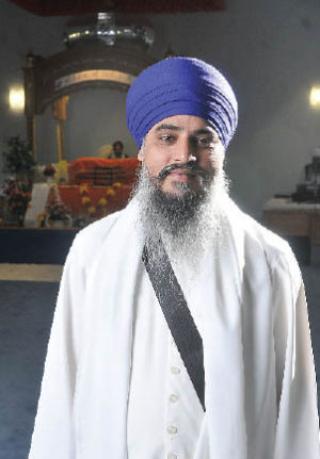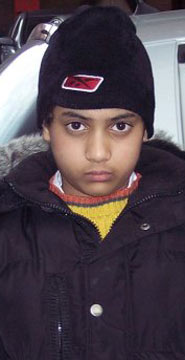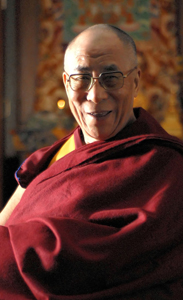
Recently, the Ontario Khalsa Darbar and the Punjabi Daily newspaper in Mississauga participated in Earth Hour to highlight the issue of climate change.
The Punjabi Daily newspaper from Mississauga has been urging its readers and Sikh
organizations to participate in EARTH HOUR. The Ontario Khalsa Darbar (Dixie Rd. Gurdwara Sahib-Sikh Place of Worship) has prepared for Earth Hour on March 29, a worldwide initiative launched by the WWF, the global conservation organization. It will be lights-off between 8 and 9 p.m. at the Gurdwara, where the hundreds gathered in the congregation will unite and use candles to pray for a cleaner and more peaceful world. “The Sikh Community has always taken a leadership role in protecting our environment. We are proud to participate in Earth Hour, which shows the Sikh communities commitment to protecting the environment, I encourage everyone to join in and turn off their lights for that one hour,” said Sukhminder Singh Hansra, of The Punjabi Daily, a Punjabi newspaper in Mississauga who urged the Sikh community join in using it’s editorials.
Earth Hour was a symbolic gesture to bring attention to the wastage of electricity and climate change. Though climate change is now almost universally accepted as a reality, its effects are often unclear. Some groups that had very little to do with contributing to its causes are already feeling the effects. Meet global warming’s first refugees (according to Sugata Hazra, the director of the School of Oceanography Studies at Kolkata’s Jadavpur University) in the Sundarbans:
This week the National Post launched a series about “Canada’s Biggest Mistakes.” Written by different columnists, yesterday’s big mistake was deficit spending. In today’s installment of the “top 5,” columnist Barbara Kay sets her sights on multiculturalism.
today’s installment of the “top 5,” columnist Barbara Kay sets her sights on multiculturalism.
I must admit I am not an avid reader of the National Post. In fact, I don’t think I had ever even heard of it prior to this column. However, Wikipedia informs me that it is a “voice for Canadian conservatives.” A brief perusal of Kay’s biggest hits, including as “Hug the Earth, kill the humans, ” “Barack Obama’s selective silence on his racist pastor, Jeremiah Wright,” and “The College Campus: Anti-Semitism’s last North American Refuge and Taking Back the Campus” helps me situate her on a political spectrum. In America, we call her David Horowitz and Bill O’Reilly. Well, enough of that, let us try to engage the substance of her argument.
Kay doesn’t mince her words on her stand:
Multiculturalism is Canada’s greatest mistake, but if it is any consolation, it is every western country’s greatest mistake. And now some of them are paying a terrible price.
PBS is currently running a fascinating documentary called Unnatural Causes which explores the racial and socioeconomic inequalities in health. Do we all have an equal chance for health? Is this inequality making us sicker? These are the questions that build the foundation for this seven-part documentary that looks at the root causes of health and illness and goes beyond popular conceptions linking health to medical care and explores evidence of more powerful determinants such as the social conditions in which we are born, live and work.
We spend more than twice the average rich country spends per person on medical care. Yet we have among the worst disease outcomes of any industrialized nation – and the greatest health inequities. At every step down the socio-economic ladder, African Americans, Native Americans and Pacific Islanders often fare worse than their white counterparts. The unequal distribution of social conditions – and their health consequences – are not natural or inevitable. They are the result of choices that we as a community, as states, and as a nation have made, and can make differently. Our international health status has fallen radically in the last few decades. In 1980, we ranked 14th in life expectancy; by 2007, we had fallen to 29th. [Link]
One issue that is particularly interesting is how racism adversely impacts an individual’s and ultimately an entire community’s health. Researchers are circling in on a way to explain the presence of worse health outcomes among minorities and suggest that the chronic stress of racism can be embedded in the body, taking a heavy toll on people of color. The researchers suggest that when you have a reaction to a situation in your life that makes you anxious or gets you stressed out, you not only have a psychological or emotional reaction but you also have a biological reaction. If that stress is chronic, over time it creates wear and tear on your body’s organs and systems and thus, causing illness. Another issue of interest is the fact that immigrants, who are often poorer, tend to be healthier than the average American. However, the longer they live here, the worse their relative health becomes, even as their economic status improves. Children of immigrants are particularly at risk for obesity, heart disease, and mental illness. The documentary explores what it is about new immigrant communities that shield people from poor health and how this protective shield erodes over time.
Both these issues are relevant to the Punjabi Sikh community. It’s important to look at the social conditions as mentioned in this documentary to help us understand the high rates of heart disease, obesity, diabetes, and mental illness that are impacting our community.
Unnatural Causes airs on PBS on Thursdays through April 17th.
The New York Sun posted an editorial today that raises the question of ‘neutrality and justice.’ Quoting from Federal Judge John Noonan in the famous case of Harpal Cheema, who was jailed for six years on suspicion of fundraising for the Khalistan Commando Force:
“Contrary to the government’s assertion, it is by no means self-evident that a person engaged in extra-territorial or resistance activities — even militant activities — is necessarily a threat to the security of the United States. One country’s terrorist can often be another country’s freedom-fighter.”
The New York Sun editorial calls for giving amnesty to two freedom fighters that fought/are fighting against communist regimes. General Vang Pao, is a hero to most Hmong-Americans, and maybe even known to our readers in Sacramento, Fresno, and other locales with high Hmong concentrations. General Pao is facing weapon charges for attempting to aid Hmong militants against the Laotian regime. The other, Cambodian-American Yasith Chhun, attempted something similar against the Cambodian government.
As the summer Olympics game approaches and we are repeatedly reading of continued Tibetan freedom protesters against the Chinese government. What should be the role of Tibetans in America? Should America (or fill in whatever country you are from) provide a space for dissenters to come together? For Irish-Americans, Jewish-Americans, South African-Americans, the American soil has always allowed this ground. Some chose organizations that were not violent, but many did not. What should be the limitations? Is it violence? However, even here it becomes murkier. In Harpal’s case, he didn’t engage in any violence, but he did fundraise for certain groups. What is our barometer of justice? Should the American judicial system be wed to the existing nation-state set-up in the world? Or is the metric the relationship between the opposed state and the United States?
Wishing all of you a great weekend. Although this is old, hopefully it will make you laugh….including some fellow bloggers that aren’t having a great day.
For anyone in the D.C. area interested in Jhumpa Lahiri’s writing- she is on a book tour and will be speaking at Sixth & I on Wednesday, April 23 at 7 pm.
 Tickets are available at Politics & Prose for $6 or you can buy the book for $25 and get 2 free tickets with it. Contact P & P at 202. 364. 1919.
Tickets are available at Politics & Prose for $6 or you can buy the book for $25 and get 2 free tickets with it. Contact P & P at 202. 364. 1919.
Jhumpa Lahiri’s stories about the Indian-American diaspora vividly evoke both the ambivalence of the older generation – appreciating their adopted nation, but feeling dislocated – and the freedom of the younger generation, unfettered by their South Asian origins, except for parental expectations. Lahiri won the Pulitzer Prize for The Interpreter of Maladies, and her second novel, The Namesake, was adapted to a film in 2007.
A little more info: Lahiri’s new collection of stories (as well as her older works) elegantly capture the way we navigate dual cultures.
Assimilation, in Lahiri’s fiction, is about coming to terms with disorientation. It is about not fitting in or settling down, not starting over from scratch and freely forging a new identity or destiny. Her characters balance precariously between two worlds—not just Asian and Western, but inner and outer…
The question is poignant: What makes anyone want to blow themselves up for a cause?
As the discussion of violence has manifested itself a number of times on this young blog, I read with interest discussions of this documentary, My Daughter the Terrorist. As most discussions on political violence are the tales of men or women-victims, often using the language of chest-beating and revenge or human rights and dignity, this documentary seems to focus on a different tale. From its own webpage it states:
In this intimate and personal portrait we join two young female elite soldiers trained for the ultimate mission. We share their childhood experiences, their dreams and their families’ loss. Left behind are the mothers. [Emphasis added]
How many of you have ever heard the following words from your parents, “Become a Doctor, (feel free to interchange with Lawyer or Engineer for the same effect)!”?
Our generation is definitely starting to see the freedom to pursue career paths that are unconventional to our parents’ or their parents’ generation. When you realize you will ultimately be doing the same job for the rest of your life, you begin to think about what you’re most “passionate” about. Many parents are coming around to the idea that there are many lucrative fields of work for their children to pursue and which they are “passionate” about.
Last week I heard journalist Lisa Ling say that she is often asked to speak at college graduations, and the one thing she feels a lot of students are doing is studying for a career, rather than studying to become a well-rounded person and allowing the career to find you.
Many of us are told to pursue a “stable” career first, and do your “hobby” on the side. Although patterns have shown that Sikhs are probably one of the most entrepreneurial group of people in the world. Our ancestors before us have shown how perseverance of a dream can become a reality. Many of our parents’ generation came to the West with a few dollars, or pounds, in their pocket to begin their new life- and live the American Dream.
Shifting focus from the hoopla surrounding this year’s Surrey’s Vaisakhi Nagar Kirtan, I found just a nice piece highlighting one Sikh Granthi’s service. While we often comment on those granthis that are corrupt, perverse, and all kinds of bad adjectives that I could list, I still believe that this is the exception not the rule. Unfortunately, their actions have maligned many. Here is Surrey’s Granthi Narinder Singh that is letting his actions at the local hospital speak:
those granthis that are corrupt, perverse, and all kinds of bad adjectives that I could list, I still believe that this is the exception not the rule. Unfortunately, their actions have maligned many. Here is Surrey’s Granthi Narinder Singh that is letting his actions at the local hospital speak:
The elderly lady with the long grey hair was furious. The stroke that had confined her to a wheelchair and restricted her ability to move had also left her unable to speak. But her eyes were flashing with indignation and she was clearly greatly offended about something. She kept pointing at her chest.
Singh, who regularly visited the hospital to conduct religious services for Sikh patients, had forged a friendly relationship with the dignified older woman, evolving an improvised sign language to communicate.
She would even let him comb her hair, something she refused to permit the nurses to do. He could see the problem right away. Someone, probably a well-meaning nurse, had buttoned up the lady’s sweater for her, but got the buttons in the wrong order. Her garb was crooked and she didn’t have enough mobility in her hands to fix it. Singh re-buttoned the sweater properly. She smiled, threw her arms wide and hugged him.
On March 24th, His holiness the 14th Dalia Lama, Tenzin Gyatso, was named the first recipient of the Guru Nanak Interfaith Prize, awarded by Hofstra University.
The $50,000 prize, which recognizes efforts at interfaith dialogue, will be presented to His Holiness on November 18, 2008 in India by a delegation including Hofstra officials, the family of Sardar Ishar Singh Bindra, which established the prize at Hofstra, and former Indian Prime Minister I.K. Gujral, a member of the Guru Nanak Interfaith Prize Honorary Committee. The Dalai Lama has agreed to visit Hofstra in the near future.
The Prize:
The biennial prize for $50,000 was established at Hofstra University in 2006 by the family of Sardar Ishar Singh Bindra to encourage and award organizations and people who strive to increase dialogue amongst people of different faiths and understanding. A chair of Sikh Studies, the Sardarni Kuljit Kaur Bindra Chair, named after the family’s matriarch was also established at the same time.
As the founder of Sikhism, Guru Nanak taught that we discover our oneness with humanity by exploring the differences that separate us. The Guru Nanak Interfaith Prize recognizes and supports the efforts of those individuals and organizations who work to advance that vision.
In an interesting twist an Indian Bihari family is claiming that the 9-years-old Gurrinder is really their kidnapped son 6-years-old Shintu Kumar, who was kidnapped on March 3rd of this year.
really their kidnapped son 6-years-old Shintu Kumar, who was kidnapped on March 3rd of this year.
The mother has stated:
“We saw his photo too [on TV]… I know my child.”
The Bihari police have stated that a DNA test will need to be conducted before proceeding further. The family was able to move immediately as the mother is related to a prominent Bihari legislator. Officials in England have been notified. Our thoughts are with the child and hope that he is being taken care of and that he may be reunited with his proper family soon. More as it become available….
—————————————————————————————
Although there may be more pressing global news, especially as the morning newspapers report about the 4,000th death of an American soldier, along with the soon approaching 90,000 projected Iraqi civilian deaths, in the last six years in Iraq, I start the week with a question that is being asked by the Sikh community in Southall (London, UK). Who is this child?
Right after I graduated college, I moved to semi-rural Kenya. I had heard that there was a historic desi/Sikh population, so I looked for the nearest gurdwara. I found it two hours away on Temple Road in Kisumu, Kenya’s third largest city and the cultural capital of Luo-land.
The Guru Nanak Gurdwara is pleasant with a diverse sangat, but even more exciting was the building across the street — the “Guru Nanak Harambee Dispensary Center.” The dispensary center is as big, if not bigger, than the gurdwara itself. I found it refreshing that the gurdwara not only serves langar each day, but it has devoted equal resources to (re)distributing aid.
It’s hard to give a good translation of “harambee,” but it reflects a community coming together to do good work. If I had to distill it into keywords, I’d pick unity, mobilization, and empowerment. These concepts reminded me of our earlier conversation on daswand. In Kenya, harambee is a means of reaching across differences in wealth, tribal ancestry, gender, and profession. I believe that daswand, paired with seva, attempts to build community in similar ways.
Throughout the world, the reverberations of Kosovo’s independence are still being felt. A number of nations have continued to recognize the new country, the latest including Canada.  The issue of self-determination was raised earlier and I want to return to it for this brief post.
The issue of self-determination was raised earlier and I want to return to it for this brief post.
The word ‘balkanization’ has entered out vocabulary. Although first coming about with the fall of Tito’s regime, it has come to mean different ethnic groups breaking into smaller ‘ineffectual’ regimes. The word has an extreme negative denotation [check out the dictionary.com definition]. No longer quite relevant in Europe, it flows East to look at remnant Empires — maybe China and India. These two states are much larger than any existing nation-state. They are imperial remnants from a bygone age.
With Kosovo’s declaration of independence, commentators from China and India have been quick to reply. Indian newspapers are full of headlines such as “Kosovo’s declaration places India in a quandary” and “Why India must oppose Kosovo’s independence.” Newspapers in China are little different. The current situation in Tibet China, may be read in light of what has occurred in Kosovo and the international spotlight with the upcoming Olympic Games.
Bloggers have discussed past achievements in the Sikh community and ideas for future efforts in collective action. But we haven’t yet really talked about what this collectivism is, where the contrasting individualism stems from, and what both entail.
What’s the difference between an individualist and a collectivist psychology? Collectivists emphasize group harmony and duties to the group over their individual, personal goals. They emphasize cooperation, respectfulness, and loyalty. Collectivists tend to communicate in spirals, taking a scenic route to tell a story and generally avoid conflict because it disrupts group harmony. In contrast, individualists value personal freedom, self-reliance, competition, and personal achievement over anyone else’s. Individualists see conflict as a positive opportunity for change and prefer to address it directly. Strong individualists like many Americans are rigidly linear in their communication.
I’m sure we’ve all experienced spiral communication. Think of your dadaji telling a story in a way that incorporates the broad history of the era, and every group in the village, maybe even details like the type of birds that were flying through the air at that moment in time. He will get to the point of the story in a winding, colorful manner.
Last week’s Fortune magazine named Apple the most admired company. Being a fan of Apple’s innovative products for some time, I read the article with pride. The article was very interesting and talked a great deal about Steve Jobs and his struggles to get where he is today.  However, there was one thing I learned from the article that disappointed me, and that was the fact that Apple is one of the least philanthropic companies in the world. On the other hand, Bill Gates’ company Microsoft may have been 16th on this list, but they are considered one of the most philanthropic companies globally. This article facilitated some personal thought to my own quest in giving enough back to the community, and what the importance of charity is in our Sikhi. Wand kay shako is one of the three main concepts of Sikhi, which encourages Sikhs to share their earnings with those less fortunate than ourselves. Guru ka Langar is a way in which we distribute this concept in the Gurdwaras. Dasvandh is donating a tenth of our earnings. It’s interesting that there are many religions that uphold the concept that “a tenth” of your income should be donated to charity in some form.
However, there was one thing I learned from the article that disappointed me, and that was the fact that Apple is one of the least philanthropic companies in the world. On the other hand, Bill Gates’ company Microsoft may have been 16th on this list, but they are considered one of the most philanthropic companies globally. This article facilitated some personal thought to my own quest in giving enough back to the community, and what the importance of charity is in our Sikhi. Wand kay shako is one of the three main concepts of Sikhi, which encourages Sikhs to share their earnings with those less fortunate than ourselves. Guru ka Langar is a way in which we distribute this concept in the Gurdwaras. Dasvandh is donating a tenth of our earnings. It’s interesting that there are many religions that uphold the concept that “a tenth” of your income should be donated to charity in some form.
Although I know that other religions are strict in making sure this donation is made on an annual level, I am not sure whether we are as philanthropic? How much are you as families donating to the cause of Wand kay Shako? We are lucky to be a part of a religion that is so progressive and way ahead of the times. There is even more we can do to be more involved in the concept of “giving back”, because there are a growing number of organizations that are allowing us to contribute our “dasvandh” for a great cause – such as Sikhcess, Sikh Coalition, Sikhnet, and Sikh Giving. Many of these organizations have been started by our generation, which shows we truly are a generation of change and a generation of humanity!
Recently on “The Langar Hall” there has been discussion about “Runaway Grooms” who with their immigration status abroad marry women from Punjab, only to abandon them after receiving the dowry. Along with being deserted by their husbands, these women’s “dreams” of going abroad are also shattered. These “dreams” were generally a primary reason many of the women were married to these men. Hasit Shah writes in his BBC news article,
“You can see it around you. There is a lot of foreign money in this city [Jalandhar]. The NRIs have been coming back and building huge houses and flaunting their success. The locals see this and want a better life for their daughters, but when the husband is unscrupulous, the women’s lives are ruined.”
Many Punjabi men in Punjab/India are also tremendously influenced by this wealth and have dreams of going abroad (a lot of it has to do with lack of job/economic opportunities in Punjab). NRI women’s green cards and citizenship status become routes for gaining permanent residency abroad. Interestingly, it is the “unscrupulousness” behavior of “husbands” and gendered power dynamics prevalent in “Runaway Groom” situations that translate into the predicaments faced by a growing number of NRI women who are also manipulated and abused by their Punjabi Sikh husbands from Punjab/India. Their “husbands” were not interested in a marriage … they really only wanted the money and permanent residency abroad. I completely agree that this is not the outcome of all NRI and non-NRI marriages. Many couples are very happy. Yes, I acknowledge that the circumstances are different for NRI and non-NRI women based on the power hierarchy between the
Last week, an article appeared in the Toronto Star by a young university student, Jasmeet Sidhu. In the article Jasmeet discusses her [is this gender assumptions or what, the name given is only Jasmeet Sidhu and nowhere in the article does it state whether she is male or female, but I am assuming female based on her music tastes] problems with living the life of a “bicultural suburban teen.” Now this topic is hardly new to the The Langar Hall. In fact in some ways, it has been discussed here in various manifestations many many many times.
problems with living the life of a “bicultural suburban teen.” Now this topic is hardly new to the The Langar Hall. In fact in some ways, it has been discussed here in various manifestations many many many times.
Jasmeet’s case seems to follow a similar story. Tired of the what she feels is the hypocrisy of her own community, she is attracted by the lures of greater Canadian society. [An interesting assumption here is that Punjabi-Canadian society can never be considered ‘Canadian’ despite the huge presence, influence, and cross-cultural encounters that have spanned for more than a century.]
For Jasmeet and for many others, the world seems only binaries:
Bhangra or Rihanna? Arranged or “love” marriages?
Too often in the diaspora, Sikhs are discouraged from becoming involved with the politics of their homeland. While on certain occasions I have been critical of special ‘entitlements‘ and malicious effects the diaspora has had on the Punjabi homeland, sometimes our political workings can bring about great effects.
political workings can bring about great effects.
In an earlier post, I had mentioned what I believed to be the Top 5 Sikh Successes of 2007. At #2 I mentioned the Pakistani Sikh Anand Marriage Act. This certainly has been a long demand from the community. In fact it was due to the nullification of the Anand Marriage Act of 1909 and the lumping of Sikhs as “Hindus” in the Indian Constitution that Sikh representatives refused to ratify the constitution.
Sant Jarnail Singh Bhindranwale often reminded Sikhs that if they believe they have an independent status within the Indian state, look no further than their marriage certificate that is signed under the ‘Hindu Marriage Act’ and compare that to the separate status of the Muslim and Christian communities. The efforts of the Pakistan Sikh Gurdwara Prabandhak Committee and the American Gurdwara Parbhandak Committee led to the announcement last year that Pakistan will recognize and enact legislation recognizing the Anand Marriage Act.
It seems that this political pressure may mark dividends for Sikhs in Punjab. This week, the Indian Law and Justice Minister HR Bhardwaj stated that the government of India is planning to bring in a special marriage act for the Sikhs.
He said the Government has taken note of demands in this regard from various Sikh organisations and “there should not be a problem” in introducing such an act.
“We will bring it soon,” he said replying to supplementaries.
Reality? An empty promise? We’ll find out soon….
So yesterday I had to fill my car with gas. I never really pay attention to the price of gas until I get to the pump. Yikes!! Is it really $3.75?? And that is just for the 87 octane. I feel bad for the ‘ballers’ in our community that choose to drive expensive redundant SUVs and other vehicles that might come in handy should the apocalypse strike.
and other vehicles that might come in handy should the apocalypse strike.
All over the media, we are hearing about the scary $4/gallon that is coming up. Most of these articles read the same. However, a recent article on the same subject in the Fresno Bee reminded me of another factor…we own these businesses.
Harry Dhaliwal, owner of the Olive Avenue Chevron, said he sympathizes with his customers, who are increasingly making smaller purchases of gas.
“It used to be people would spend $20, or $30, and now it’s more like $10 and $20,” Dhaliwal said. “The only people who fill up anymore are the people with the credit cards. What does that tell you?”
So let’s here our take. Are you driving less? Are you considering to join the hybrid craze? If you own a gas station, what has been the effect on your family? At least from the Fresno Bee poll, people are not putting the blame on gas stations. So, will there still be too many Hummers in the Gurdwara parking lot on Sunday?
The Economic Times of India in its ‘Special Pages’ section last week carried an extended article titled Simmering Discontent: Sikhs in Punjab are fighting many wars.
The article sought to understand the ‘current and cross-currents’ of Punjabi society.
At the forefront were:
-
The rise of the Dera-complex – the article cites that over 10 Deras in Punjab currently have over 100,000 followers, the largest being Dera Sacha Sauda, but the actual number of smaller Deras is almost infinite, only limited by the number of actual villages in Punjab
-
The burning issue of caste
-
Rising unemployment and the stagnation of the Green Revolution economy
-
Drug Addiction
While the journalist, Praveen Thampi is most interested in asserting his political point:
“Punjab has burning issues to address. But the only people interested in revival of the Khalistan movement are the journalists coming down from Delhi.”
Although quoting another journalist about this issue, Thampi falls into the same trap. Instead of finding solutions and proposals for these burning problems, Thampi wants to waive the ‘Khalistan’ boogeyman to sensationalize his news.
So using some of the information, Thampi uncovers I humbly submit some of my thoughts on these four problems and invite other readers to comment, disagree, and suggest their own.


 The $50,000 prize, which recognizes efforts at interfaith dialogue, will be presented to His Holiness on November 18, 2008 in India by a delegation including Hofstra officials, the family of Sardar Ishar Singh Bindra, which established the prize at Hofstra, and former Indian Prime Minister I.K. Gujral, a member of the Guru Nanak Interfaith Prize Honorary Committee. The Dalai Lama has agreed to visit Hofstra in the near future.
The $50,000 prize, which recognizes efforts at interfaith dialogue, will be presented to His Holiness on November 18, 2008 in India by a delegation including Hofstra officials, the family of Sardar Ishar Singh Bindra, which established the prize at Hofstra, and former Indian Prime Minister I.K. Gujral, a member of the Guru Nanak Interfaith Prize Honorary Committee. The Dalai Lama has agreed to visit Hofstra in the near future.